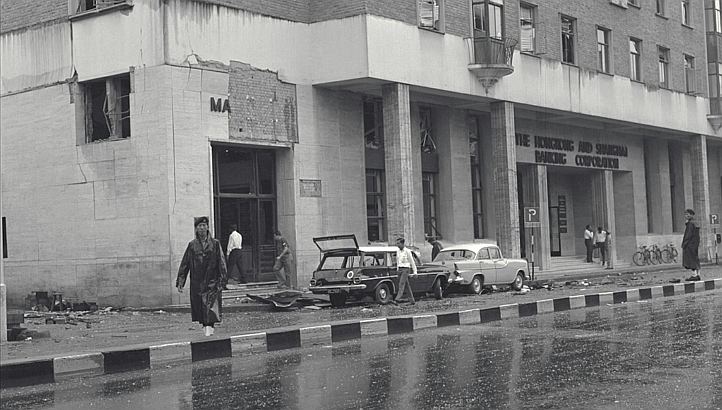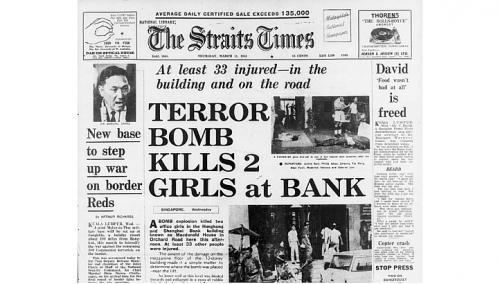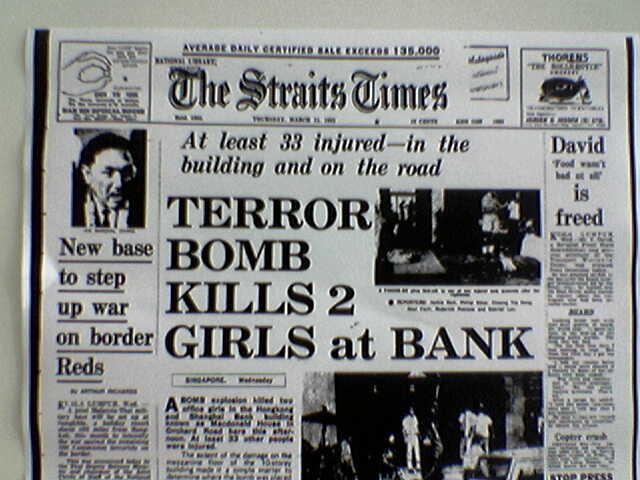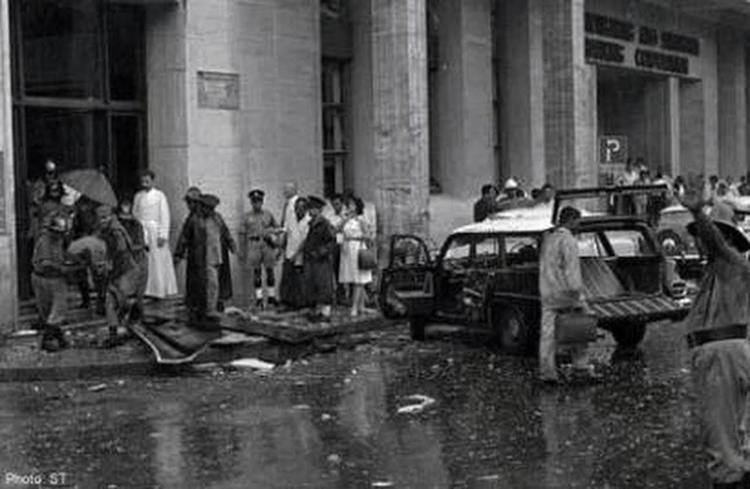Start date March 10, 1965 | ||
 | ||
Similar Bukit Ho Swee Fire, Singapore Airlines Flight 117, Collapse of Hotel New World, SilkAir Flight 185, Singapore Airlines Flight 006 | ||
The MacDonald House bombing occurred on 10 March 1965, at the Hong Kong and Shanghai Bank building (now known as MacDonald House) along Orchard Road of Singapore, which was then part of Malaysia. The time bomb was planted by a duo of Indonesian saboteurs, during the period of Indonesia–Malaysia confrontation (also known as Konfrontasi). The explosion killed three people and injured at least 33 others.
Contents
- Macdonald house bombing survivor recounts ordeal
- Background
- Attack
- Arrests and sentencing
- Memorial
- Aftermath and effects on Indonesia Singapore bilateral relations
- Warship naming controversy
- References

Macdonald house bombing survivor recounts ordeal
Background

During the Indonesian Konfrontasi where Indonesia openly opposed the formation of Malaysia, Indonesian saboteurs mounted a campaign of terror in Singapore. There were a total of 37 bombings from 1963 to 1966 carried out by the Indonesian saboteurs. They were trained to attack military installations and public utilities. However, when the saboteurs failed in their attempts to attack these installations that were heavily guarded, they set off bombs indiscriminately to create panic and disrupt life on the island. By 1964, bomb explosions became frequent. To help the police and army defend Singapore from these bomb attacks, a volunteer force was set up. More than 10,000 people signed up as volunteers. Community Centres served as bases for the volunteers to patrol their neighbourhoods. In schools, students underwent bomb drills. The government also warned Singaporeans not to handle any suspicious-looking parcels in the buildings or along streets. Despite the efforts of the British, small groups of saboteurs managed to infiltrate the island and plant bombs. By March 1965, a total of 29 bombs had been set off in Singapore.
Attack

10 March 1965 bombing of the MacDonald House was the most serious of the spate of bombings in Singapore, when a bomb exploded at 3:07pm at the 10-storey building. The bomb killed three people, two were employees of the Hong Kong and Shanghai Bank, Elizabeth Suzie Choo, 36, a secretary and Juliet Goh, 23, a clerk. The third victim, Mohammed Yasin Kesit, 45, a driver, slipped into a coma after the blast, and did not come out of it. Thirty-three other people were injured. At the time of the bombing, the building had also housed the Australian High Commission and the Japanese Consulate, and was located just 1.4 km from the Istana, now the official residence of the President of Singapore.
Arrests and sentencing

Within four days, Singaporean police arrested two Indonesian marines, Harun Said (then 21) and Osman Mohamed Ali (then 23) for the bombing. The two saboteurs had arrived in Singapore from Java at 11:00 a.m., wearing civilian clothes. They had been instructed to bomb an electric power house but instead headed to MacDonald House. As they were in civilian clothes and had targeted a civilian building, the men were tried in Singapore for the murder of the three people who died in the blast. They were convicted and hanged in 1968.
Memorial

On 10 March 2015, 50 years after the bombing, a memorial dedicated to the victims of the Konfrontasi as well as soldiers who died during that period, was unveiled at Dhoby Ghaut Green, situated across MacDonald House. It was built at the recommendation of the Singapore Armed Forces Veterans League (SAFVL) with the objective as a remembrance of the victims, as well as to educate younger generations about the tragedy. The unveiling was officiated by Minister for Culture, Community and Youth Lawrence Wong, as "a lasting reminder of the victims of Konfrontasi, and those who risked their lives defending our country". Religious leaders from the Inter-Religious Organisation also prayed at the site, before laying a wreath on the monument.
Aftermath and effects on Indonesia-Singapore bilateral relations
In the meantime, Singapore had seceded from Malaysia on 9 August 1965, just five months after the bombing. In March 1967, the then President of Indonesia, Sukarno, who had initiated the Konfrontasi, was removed from power. A clemency plea by Suharto, who assumed the position of President, was rejected. The Singapore Embassy in Jakarta was ransacked on the day of the saboteurs' hanging. Bilateral-relations between Singapore and Indonesia remained tense. Bilateral relations improved after 1973, when the then Prime Minister of Singapore, Lee Kuan Yew, in a visit to Indonesia, visited the graves of the two marines and scattered flowers on them, followed by Suharto's visit to Singapore in 1974.
Warship-naming controversy
In 2014, Indonesia named a Bung Tomo-class corvette warship as KRI Usman-Harun, after the two hanged commandos, worsening bilateral ties between Indonesia and Singapore. In response, Singapore cancelled a series of planned inter-military activities and banned the warship from its ports and naval bases and also withdrew its delegation from an international defence meeting, after two Indonesian men at the event were seen dressed in uniform. General Moeldoko, Indonesia's military chief, apologised for the naming of the ship, which was accepted by Singapore in a statement by Singapore Defence Minister Ng Eng Hen.
